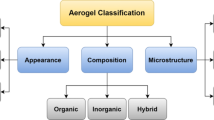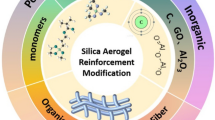Abstract
The isotactic polypropylene – modified silica (iPP/SiO2) hybrid nanocomposites, obtained by grafting polypropylene chains on amine-functionalized silica particles during reactive blending, were studied. It was found that use of amine-functionalized silica and PP-g-MA as a compatibilizer improved dispersion of nanoparticles. Nanosilica, especially surface-modified, revealed some nucleation activity towards iPP, manifesting in an increase of the crystallization temperature and reduction of spherulite size. iPP/silica nanocomposites exhibit highly improved thermo-oxidative stability, due to formation of a silica protective layer, limiting the polymer volatilization rate. Nanocomposites demonstrate enhanced stiffness and strength, but at higher silica content the ductility is nearly lost due to presence of big agglomerates, acting as critical-sized structural flaws. At low silica concentrations dispersion was improved and big agglomerates were not observed. Consequently, iPP/PP-g-MA/am-SiO2 nanocomposites with low silica content demonstrate high ductility and enhanced impact resistance, related to reinforcing effect of well dispersed silica particles.













Similar content being viewed by others
References
Paul DR, Robeson LM (2008) Polymer nanotechnology: nanocomposites. Polymer 49(15):3187–3204
Njuguna J, Pielichowski K, Desai S (2008) Nanofiller-reinforced polymer nanocomposites. Polym Adv Technol 19(8):947–959
Pavlidou S, Papaspyrides CD (2008) A review on polymer–layered silicate nanocomposites. Prog Polym Sci 33(12):1119–1198
Zhang MQ, Rong MZ, Ruan WH (2009) Nanoparticles/polymer composites: fabrication and mechanical properties. In: Karger-Kocsis J, Fakirov S (eds) Nano- and micro-mechanics of polymer blends and composites. Hanser, Munich, pp. 93–140
Zou H, Wu S, Shen J (2008) Polymer/silica nanocomposites: preparation, characterization, properties, and applications. Chem Rev 108(9):3893–3957
Sun LY, Gibson RF, Gordaninejad F, Suhr J (2009) Energy absorption capability of nanocomposites: a review. Compos Sci Technol 69(14):2392–2409
Choudalakis G, Gotsis AD (2009) Permeability of polymer/clay nanocomposites: a review. Eur Polym J 45(4):967–984
Zhao C, Qin H, Gong F, Feng M, Zhang S, Yang M (2005) Mechanical, thermal and flammability properties of polyethylene/clay nanocomposites. Polym Degrad Stab 87(1):183–189
Michler GH, Balta-Calleja FJ (2012) Nano- and micromechanics of polymers. Carl Hanser Verlag, Munich
Iler RK (1979) The chemistry of silica. Wiley, New York
Kim HC, Dubois G (2005) Dekker encyclopedia of nanoscience and nanotechnology. Taylor & Francis, New York
Jana SC, Jain S (2001) Dispersion of nanofillers in high performance polymers using reactive solvents as processing aids. Polymer 42:6897–6905
Nalwa HS (ed) (2003) Handbook of organic-inorganic hybrid materials and nanocomposites. American Scientific Publishers, Stevenson Ranch
Pegoretti A (2009) Creep and fatigue behaviour of polymer nanocomposites. In: Karger-Kocsis J, Fakirov S (eds) Nano- and micro-mechanics of polymer blends and composites. Hanser, Munich, pp. 301–339
Wu CL, Zhang MQ, Rong MZ, Friedrich K (2002) Tensile performance improvement of low nanoparticles filled-polypropylene composites. Compos Sci Technol 62(10–11):1327–1340
Bikiaris DN, Vassiliou A, Pavlidou E, Karayannidis GP (2005) Compatibilisation effect of PP-g-MA copolymer on iPP/SiO2 nanocomposites prepared by melt mixing. Eur Polym J 41(9):1965–1978
Bikiaris DN, Papageorgiou GZ, Pavlidou E, Vouroutzis N, Palatzoglou P, Karayannidis GP (2006) Preparation bv melt mixing and characterization of isotactic polypropylene/SiO2 nanocomposites containing untreated and surface-treated nanoparticles. J Appl Polym Sci 100(4):2684–2696
Bouaziz A, Jaziri M, Dalmas F, Massardier V (2014) Nanocomposites of silica reinforced polypropylene: correlation between morphology and properties. Polym Eng Sci 54(9):2187–2196
Chen JH, Rong MZ, Ruan WH, Zhang MQ (2009) Interfacial enhancement of nano-SiO2/polypropylene composites. Compos Sci Technol 69(2):252–259
Lin OH, Mohd Ishak ZA, Akil HM (2009) Preparation and properties of nanosilica-filled polypropylene composites with PP-methyl POSS as compatibiliser. Mater Des 30(3):748–751
Rong MZ, Zhang MQ, Pan SL, Friedrich K (2004) Interfacial effects in polypropylene-silica nanocomposites. J Appl Polym Sci 92(3):1771–1781
Studziński M, Jeziórska R, Szadkowska A, Zielecka M (2014) Modified nanosilica-filled polypropylene composites with glycidyl methacrylate grafted ethylene/n-octene copolymer as compatibilizer. Polimery 59:625–635
Garcia M, van Vliet G, Jain S, Schrauwen BAG, Sarkissov A, van Zyl WE, Boukamp B (2004) Polypropylene/SiO2 nanocomposites with improved mechanical properties. Rev Adv Mater Sci 6(2):169–175
Papageorgiou DG, Vourlias G, Bikiaris DN, Chrissafis K (2014) Effect of silica nanoparticles modification on the thermal, structural, and decomposition properties of a β-nucleated poly(propylene-co-ethylene) matrix. Macromol Chem Phys 215(9):839–850
Pavlidou E, Bikiaris D, Vassiliou A, Chiotelli M, Karayannidis G (2005) Mechanical properties and morphological examination of isotactic polypropylene/SiO2 nanocomposites containing PP-g-MA as compatibilizer. J Phys Conf Ser 10(1):190–193
Zhou RJ, Burkhart T (2011) Polypropylene/SiO2 nanocomposites filled with different nanosilicas: thermal and mechanical properties, morphology and interphase characterization. J Mater Sci 46(5):1228–1238
Zoukrami F, Haddaoui N, Vanzeveren C, Sclavons M, Devaux J (2008) Effect of compatibilizer on the dispersion of untreated silica in a polypropylene matrix. Polym Int 57(5):756–763
Taniike T, Toyonaga M, Terano M (2014) Polypropylene - grafted nanoparticles as a promising strategy for boosting physical properties of polypropylene-based nanocomposites. Polymer 55(4):1012–1019
Karian HG (ed) (2003) Handbook of polypropylene and polypropylene composites. Plastics Engineering. Marcel Dekker, New York
Rong MZ, Zhang MQ, Zheng YX, Zeng HM, Walter R, Friedrich K (2001) Structure–property relationships of irradiation grafted nano-inorganic particle filled polypropylene composites. Polymer 42(1):167–183
Boyer C, Boutevin B, Robin JJ (2005) Study of the synthesis of graft copolymers by a reactive process. Influence of the copolymer structure on the adhesion of polypropylene onto poly(vinylidene fluoride). Polym Degrad Stab 90(2):326–339
Fina A, Tabuani D, Peijs T, Camino G (2009) POSS grafting on PPgMA by one-step reactive blending. Polymer 50(1):218–226
Fina A, Monticelli O, Camino G (2010) POSS-based hybrids by melt/reactive blending. J Mater Chem 20(42):9297–9305
Grala M, Bartczak Z, Pracella M (2013) Morphology and mechanical properties of polypropylene-POSS hybrid nanocomposites obtained by reactive blending. Polym Compos 34(6):929–941
Krigbaum WR, Uematsu I (1965) Heat and entropy of fusion of isotactic polypropylene. J Polym Sci A Polym Chem 3(2):767–776
Wojdyr M (2010) Fityk: a general-purpose peak fitting program. J Appl Crystallogr 43:1126–1128
Turner-Jones A, Aizlewood JM, Beckett DR (1964) Macromol Chem 75:134–158
Alexander LE (1969) X-ray diffraction methods in polymer science. Wiley-Interscience, New York
Kurth DG, Bein T (1992) Quantification of the reactivity of 3-aminopropyl-triethoxysilane monolayers with the quartz-crystal microbalance. Angew Chem Int Ed Engl 31(3):336–338
Kurth DG, Bein T (1993) Surface reactions on thin layers of silane coupling agents. Langmuir 9(11):2965–2973
Ek S, Iiskola EI, Niinistö L (2004) Atomic layer deposition of amino-functionalized silica surfaces using N-(2-aminoethyl)-3-aminopropyltrimethoxysilane as a silylating agent. J Phys Chem B 108(28):9650–9655
Sen T, Bruce IJ (2012) Surface engineering of nanoparticles in suspension for particle based bio-sensing. Sci Report 2:564
van de Waterbeemd M, Sen T, Biagini S, Bruce IJ (2010) Surface functionalisation of magnetic nanoparticles: quantification of surface to bulk amine density. Micro Nano Lett 5(5):282
Bruce IJ, Sen T (2005) Surface modification of magnetic nanoparticles with alkoxysilanes and their application in magnetic bioseparations. Langmuir 21(15):7029–7035
Choi S-H, Cai Y, Newby B-MZ (2007) Stability Enhancement Of Polystyrene Thin Films On Aminopropyltriethoxysilane Ultrathin Layer Modified Surfaces. In: Silanes and Other Coupling Agents, Volume 4.
Wåhlander M, Nilsson F, Larsson E, Tsai W-C, Hillborg H, Carlmark A, Gedde UW, Malmström E (2014) Polymer-grafted Al2O3-nanoparticles for controlled dispersion in poly(ethylene-co-butyl acrylate) nanocomposites. Polymer 55(9):2125–2138
van Blaaderen A, Vrij A (1993) Synthesis and characterization of monodisperse colloidal organo-silica spheres. J Colloid Interface Sci 156(1):1–18
Pedrazzoli D, Pegoretti A, Kalaitzidou K (2015) Understanding the effect of silica nanoparticles and exfoliated graphite nanoplatelets on the crystallization behavior of isotactic polypropylene. Polym Eng Sci 55(3):672–680
Grassie N, Scott G (1985) Polymer degradation and stabilization. Cambridge University Press, Cambridge
Fina A, Tabuani D, Carniato F, Frache A, Boccaleri E, Camino G (2006) Polyhedral oligomeric silsesquioxanes (POSS) thermal degradation. Thermochim Acta 440(1):36–42
Pawlak A, Galeski A, Rozanski A (2014) Cavitation during deformation of semicrystalline polymers. Prog Polym Sci 39(5):921–958
Dorigato A, Dzenis Y, Pegoretti A (2013) Filler aggregation as a reinforcement mechanism in polymer nanocomposites. Mech Mater 61:79–90
Ahmed S, Jones FR (1990) A review of particluate reinforcement theories for polymer composites. J Mater Sci 25:4933–4942
Nielsen LE, Landel RF (1994) Mechanical properties of polymers and composites. M. Dekker, New York
Nicolais L, Nicodemo L (1973) Strength of particulate composite. Polym Eng Sci 13:469–477
Galeski A (2003) Strength and toughness of crystalline polymer systems. Prog Polym Sci 28(12):1643–1699
Brooks NWJ, Mukhtar M (2000) Temperature and stem length dependence of the yield stress of polyethylene. Polymer 41:1475–1480
Dorigato A, D’Amato M, Pegoretti A (2012) Thermo-mechanical properties of high density polyethylene – fumed silica nanocomposites: effect of filler surface area and treatment. J Polym Res 19(6)
Kontou E, Niaounakis M (2006) Thermo-mechanical properties of LLDPE/SiO2 nanocomposites. Polymer 47(4):1267–1280
Boyd RH (1985) Relaxation processes in crystalline polymers: experimental behaviour — a review. Polymer 26(3):323–347
Boyd RH (1985) Relaxation processes in crystalline polymers: molecular interpretation — a review. Polymer 26(8):1123–1133
Bartczak Z, Galeski A (2014) Mechanical properties of polymer blends. In: Utracki LA, Wilkie CA (eds) Polymer blends handbook, vol 2, 2nd edn. Springer Science+Business Media, Dordrecht, pp. 1203–1297
Author information
Authors and Affiliations
Corresponding author
Rights and permissions
About this article
Cite this article
Grala, M., Bartczak, Z. & Różański, A. Morphology, thermal and mechanical properties of polypropylene/SiO2 nanocomposites obtained by reactive blending. J Polym Res 23, 25 (2016). https://doi.org/10.1007/s10965-015-0914-0
Received:
Accepted:
Published:
DOI: https://doi.org/10.1007/s10965-015-0914-0




